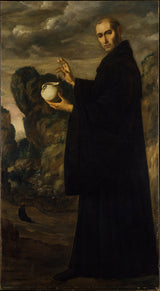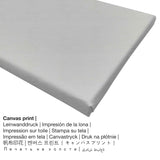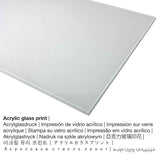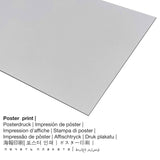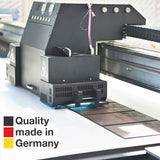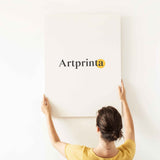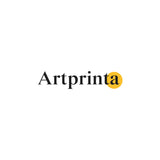Francisco de Zurbarán, 1640 - Amaghị - mbipụta nka mara mma
Ụtụ gụnyere. Mbupu gbakọrọ na ndenye ọpụpụ.
Nkọwapụta ngwaahịa zuru ezu
Unknown was made by Francisco de Zurbarán in 1640. Ụdị ihe osise a tụrụ nha: 74 x 40 3/4 na (188 x 103,5 cm) na e mere ya na Usoro mmanụ na kwaaji. Today, this piece of art is included in the art collection of The Metropolitan Museum of Art, which is one of the world's largest and finest art museums, which includes more than two million works of art spanning five thousand years of world culture, from prehistory to the present and from every part of the globe.. With courtesy of - The Metropolitan Museum of Art, New York, Bequest of Harry G. Sperling, 1971 (ikike ngalaba ọha). Creditline of the artwork: Bequest of Harry G. Sperling, 1971. In addition to that, the alignment is in Eserese format na a akụkụ ruru nke 9: 16, which implies that the length is 45% shorter than the width. The painter Francisco de Zurbarán was a European artist, whose style can be classified as Baroque. The Spanish artist lived for 66 years, born in 1598 and passed away in 1664.
(© - Ụlọ ihe ngosi nka nke obodo ukwu - www.metmuseum.org)
This painting formed part of a series of canvases representing thirteen founders of monastic orders by Zurbarán, known from copies in the Capuchin convent at Castellón de la Plana. Saint Benedict is shown holding a wine jar, in reference to a legend that a jar of poisoned wine was fractured when blessed by the saint, thus saving him. In the background Benedict kneels in prayer holding a crozier.
Nkọwa na nka nka mbụ
| Aha nka nka: | "Unknown" |
| Nhazi nka nka: | sere |
| Nhazi nka: | nka ochie |
| Time: | 17th narị afọ |
| Afọ nka: | 1640 |
| Afọ nka: | karịa afọ 380 |
| Usoro nka izizi: | mmanụ na kwaaji |
| Nha izizi (ọrụ nka): | 74 x 40 3/4 na (188 x 103,5 cm) |
| Ụlọ ihe ngosi nka: | Museumlọ ihe ngosi nka nke Obodo |
| Ebe ngosi nka: | New York City, New York, Njikota Obodo Amerika |
| Dị n'okpuru: | Museumlọ ihe ngosi nka nke Obodo |
| Ikikere nke ihe osise: | ngalaba ọha |
| Site n'aka: | Ụlọ ihe ngosi nka nke Metropolitan, New York, Arịrịọ nke Harry G. Sperling, 1971 |
| Ebe kredit nke ọrụ nka: | Arịrịọ nke Harry G. Sperling, 1971 |
Ozi izugbe gbasara onye na-ese ihe
| Aha onye nka: | Francisco de Zurbaran |
| okike nke onye nka: | nwoke |
| Obodo onye nka: | spanish |
| Ọrụ nke onye na-ese ihe: | onye na-ese ihe |
| Mba onye si: | Spain |
| Nkewa onye nka: | nna ukwu ochie |
| Ụdị nka: | Baroque |
| Nwụrụ na afọ nke: | 66 afọ |
| Amụrụ n'afọ: | 1598 |
| Nwụrụ n'afọ: | 1664 |
Nhọrọ ihe dị
For every fine art print we offer different materials and sizes. You can choose your favorite material and size among the options:
- Mbipụta akwụkwọ mmado (akwa akwa akwa): A poster print is a UV printed canvas with a fine surface finish. It is designed for placing your art replica in a custom frame. Please bear in mind, that depending on the absolute size of the canvas poster print we add a white margin of something between 2 - 6cm round about the print in order to facilitate the framing.
- Metal (aluminium debond mbipụta): These are metal prints on aluminium dibond with an impressive depth effect. Colors are luminous, fine details of the print are crisp and clear, and you can truly feel the matte appearance of the fine art print. This direct UV print on Aluminum Dibond is the most popular entry-level product and is a truly stylish way to display art prints, since it draws focus on the replica of the artwork.
- Mbipụta kanvas: A printed canvas, not to be mistaken with a painting on a canvas, is a digital copy applied on a cotton canvas. Canvas Prints have the advantage of being relatively low in weight. This means, it is easy to hang up the Canvas print without the use of any wall-mounts. Hence, canvas prints are suited for all types of walls.
- Bipụta na iko acrylic na-egbuke egbuke (nke nwere ezigbo mkpuchi iko n'elu): The acrylic glass print, which is sometimes referred to as a print on plexiglass, transforms your favorite original work of art into magnificient wall décor. Moreover, the acrylic fine art print forms a good alternative option to aluminium and canvas fine art replicas. Your favorite work of art is printed with the help of state-of-the-art UV direct printing machines. With an acrylic glass fine art print sharp contrasts and also artwork details will be more identifiable with the help of the precise tonal gradation. The real glass coating protects your selected art replica against light and heat for up to 60 years.
Ozi ngwaahịa ahaziri
| Nkewa ngwaahịa: | mmepụta nka |
| Usoro mmeghari: | dijitalụ mmeputakwa |
| Usoro mmepụta: | Mbipụta UV / dijitalụ |
| Ihe ngosi: | German mmepụta |
| Stockdị ngwaahịa: | na mmepụta ihe |
| A na-atụ aro iji ngwaahịa eme ihe: | mgbidi gallery, mgbidi ndozi |
| Nhazi nke ihe nka: | nhazi ihe osise |
| Oke akụkụ: | ( Ogologo: obosara) 9: 16 |
| Ntụgharị nkọwa akụkụ: | ogologo bụ 45% mkpụmkpụ karịa obosara |
| Nhọrọ dị: | Mpempe iko acrylic (nke nwere ezigbo mkpuchi iko), mbipụta ọla (aluminium dibond), mbipụta akwụkwọ mmado (akwụkwọ kwaaji), mbipụta kwaaji. |
| Mbipụta kanvas (akwa akwa n'elu etiti ihe ndọtị) ụdị nha dị iche iche: | 50x90cm - 20x35", 100x180cm - 39x71" |
| Mbipụta iko acrylic (nwere ezigbo mkpuchi iko) dị iche iche: | 50x90cm - 20x35", 100x180cm - 39x71" |
| Mpempe akwụkwọ mmado (akwụkwọ kwaaji) nha: | 50x90cm - 20x35" |
| Mbipụta aluminom (aluminium dibond ihe) dị iche iche: | 50x90cm - 20x35" |
| Igwe onyonyo: | adịghị |
Ederede iwu dị mkpa: We try our utmost in order to describe the products in as much detail as possible and to display them visually on the different product detail pages. At the same time, the tone of the print materials and the print result might vary slightly from the presentation on your device's monitor. Depending on your screen settings and the nature of the surface, color pigments can unfortunately not be printed one hundret percent realistically. Because all our art prints are printed and processed by hand, there might also be slight variations in the exact position and the size of the motif.
Enwere ikike nwebiisinka © | www.artprinta.com (Artprinta)

